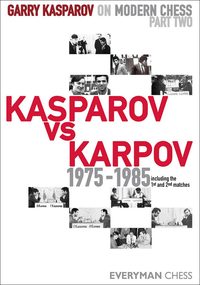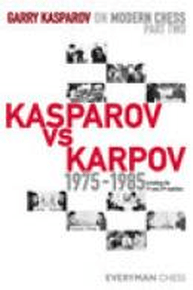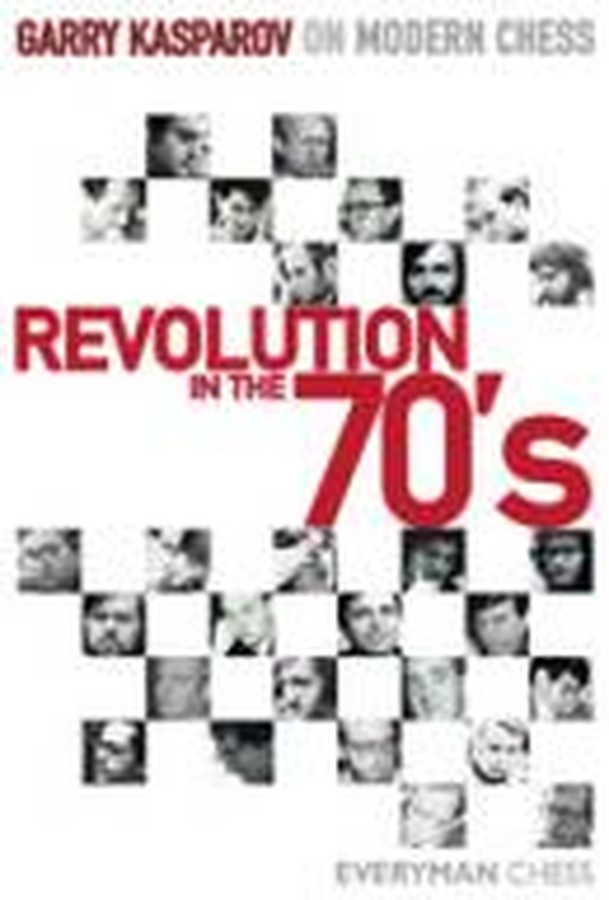| Utgivelsesdato | Februar 2007 |
| Forfatter | |
| Pris | 350 NOK |
Garry Kasparov on Modern Chess 1
Revolution in the 70'sEn utrolig spennende bok for alle sjakkfrelste, og vanskelig å plassere i kategori, men de 22 første kapitlene handler om hver sin åpning eller åpningsvariant som har satt sitt preg på moderne sjakk fra 70-tallet til i dag.
Det er en bok om "åpningsrevolusjonen", og de første kapitlene handler naturlig nok om Pinnsvinsystemet og det vi kaller Sveshnikov-varianten i siciliansk. Kasparov er i storform i denne boka som nesten opplagt måtte bli "Årets bok 2007".
Det siste kapitlet inneholder 28 tildels fantastisk gode bidrag fra "28 World Experts" som svarer på Kasparovs spørsmål om det er riktig å kalle det en åpningsrevolusjon som sannsynligvis ble utløst av Bobby Fischer og konfrontasjonen hans med den sovjetiske sjakkskolen, om hvem som var de mest revolusjonære som førte sjakken framover, hvilke åpninger som er mest radikalt endret siden 1972 osv.
Boka innleder Kasparovs nye store bokreise om og i moderne sjakk.
Forlagets egen omtale:
This book - the first in a brand new series - follows on from My Great Predecessors and sees chess legend Garry Kasparov reflecting on a pivotal time in chess history. Bobby Fischers spurt towards the chess summit (1970-1972) marked the approach of a new era affecting all aspects of the game and opening theory in particular. Fischer demonstrated the need for deep preparation with both colours. expanded the range of openings knowledge, and laid the foundations for present-day professional chess.
The leader of the new generation, Anatoly Karpov, fully reaped the benefits of the Fischer revolution by mastering the lessons of his great predecessor. Of the players of the older generation, only Victor Korchnoi wasable to achieve such a high level of professionalism.
Alas. Fischer then left the chess stage. However, the tectonic shifts he had brought about led to the beginning of a genuine revolution in opening theory - a revolution that overturned traditional impressions about many typical positions. Between 1972 and 1975 alone, progress in the field of opening theory was more significant than in the entire preceding decade! Under Fischer's influence chess was radically regenerated - a process which then continued to accelerate. As a result, from the 1972 Fischer-Spassky world championship match to 1984 and the Kasparov-Karpov matches, the overall picture of chess openings changed almost beyond recognition.
This fascinating book tells the story of this opening revolution. This story is told not only with the insight of Garry Kasparov, but also as seen through the eyes of the leading players who were at the forefront of the development of chess theory during those key years. The reader will witness at first hand how rapidly and inexorably chess development approached the coming computer era.
Era of Great Changes
With this volume I open a new, essentially autobiographical 'Modern Chess Series', which will also cover all my matches with Anatoly Karpov, my selected games, and my matches with computers. Initially the history of the openings revolution of the 1970-1980s and of the battles with Karpov was conceived as the final part of the project My Great Predecessors, but the chapter about the 12th world champion brought this to a natural conclusion. What will now be described are events in which I took a direct part.
The first of these events was the global change in the field of the opening, which began in the 1970s. True, as was shown by my poll of nearly thirty specialists, who were playing at that time and took an active part in the development of the new Systems, many do not consider those times to be revolutionary. They would argue that any revolution presupposes an upheaval in consciousness, and a revision of old dogmas which have been refuted by time itself - and this supposedly did not happen. However, in my view, the reassessment of chess values that occurred can well be called a revolution.
Glancing through the history of the development of chess thinking, we see that earlier such breakthroughs, beginning with Philidor's L'analyse du jeu des Echecs, were always associated with the names of titans. Steinitz created a theory of positional play and tried to place the playing of the opening onto scientific lines. Tarrasch conveyed Steinitz's ideas to the broad masses, and Rubinstein brilliantly developed these ideas in practice. The hypermodernists - Nimzowitsch, Reti and Grünfeld - revealed to the world openings which overturned previous conceptions about control of the centre and 'correct' pawn structure. And these openings were brought to the fore by Alekhine himself! Then Botvinnik introduced an aggressive conception for Black: instead of the usual struggle for equality, a deliberate disruption of the positional equilibrium and sharp play for seizing the initiative. Finally, Fischer demonstrated the need for the further refining and deepening of opening preparation for both colours.
Although, after becoming world champion, Fischer gave up playing, and many of his schemes soon became outdated, the tectonic shifts that he had caused generated a power-ful avalanche, which over a period of ten years redrew the entire opening 'map of the world'. Between 1972 and 1975 alone the progress in this field was more significant than in the entire preceding decade! Later the acceleration merely increased. The dynamics of the game increased sharply and, above all, there was a change in the very approach to the solving of opening problems. This was undoubtedly assisted by the rapid growth in the number of tournaments, the number of qualified players and the quantity of chess information (which was part of the worldwide information boom).
From then on, all the information no longer belonged only to a narrow circle of the chosen few, and it was not just the great players who were able to be the motivators of chess progress. In the era of the technological revolution, in chess a specialisation in research also occurred, and dozens and later hundreds of grandmasters and masters joined in the creative work. The outcome was not only a triumph of innovatory systems, which disdained centuries-old theoretical canons (the 'Hedgehog' and the Chelyabinsk Variation), but also a reassessment of existing tabiyas in the classical openings, where original schemes also emerged, based on new tactical ideas and new typical methods of fighting for an opening initiative or neutralising the opponent's initiative.
These changes were most vividly illuminated by the failure of the opening classification used in Informator - the reference book of all the participants in the revolution. This carefully devised system of indexes, developed on the basis of age-old experience, unexpectedly ceased to reflect existing reality. Whereas in the early 1970s it appeared that in general all the openings had been already examined and the 'weight' of each of them had been roughly determined, it later transpired that both theory and practice were proceeding along completely different lines. As a result, old main variations, which in the Encyclopaedia of Chess Openings had been allotted numerous pages, were removed to the periphery, whereas the currently most popular variations previously occupied... no more than one or two lines!
Opening preparation was imperceptibly but rapidly raised to a qualitatively different level. It no longer simply required play move by move, but the development of your 'own' variations, and a deep understanding of a whole class of standard positions, arising from different openings (for example, with an isolated d-pawn or 'Hedgehog'-type). The regular transformation of one opening into another and their mutual integration was one of the main results of the revolution: chess theory became an organically integrated whole! As a result, conforming with dialectical development, grandmasters and masters made a step away from narrow specialisation towards a broad range of knowledge. Universal plans and set-ups appeared. Thinking in schemes, in categories of typical middlegame positions, now took on a universal character.
This openings revolution was conclusively established in my matches with Karpov (1984-1990), which, in turn, made the game more accurate and specific, and became a kind of prologue to the computer era.
In one volume it is hardly possible to describe all the innovations of the 1970-1980s, but I will try to give as full an impression as possible of this important stage in the enormous progress that chess has taken from Philidor to the present day.
In conclusion I should like to thank the leading world chess experts for their interesting replies to my questions, and also national master Alexander Shakarov and grandmaster Yuri Dokhoian for their assistance in the preparation of this manuscript for publication.
| Innbundet? | Nei |
| Type | Bok |
| Språk | Engelsk |
Se også
-

Garry Kasparov on Modern Chess 2 Kasparov vs karpov 1975-1985
Kjøp- Pris
- 370
- Av
- Utgivelsesdato
- August 2023
-

Garry Kasparov on Modern Chess 2 Kasparov vs Karpov 1975-1985
KjøpKasparov fortsetter det store og gedigne bokprosjektet sitt og forteller i dette bindet historien om de 76 første partiene sine mot Karpov, fra et simultanparti 1975 til og med 24. og siste parti 9. november 1985 da han ble verdensmester.
- Pris
- 445
- Nivå
- B-D
- Av
- Utgivelsesdato
- September 2008

